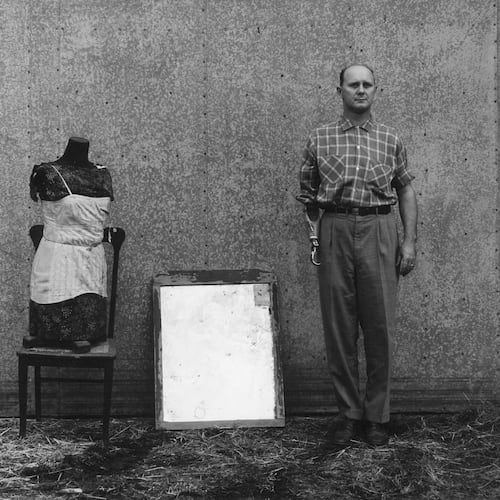This story was originally published by ArtsATL.
Two very different exhibitions currently on view demonstrate how in visual art — to modify a no longer popular saying — what you see is not necessarily what you get.
“Invisible Forces,” at Johnson Lowe Gallery through Sept. 14, is explicitly devoted to showing what is invisible within the visible in art, what the exhibition statement calls “the hidden elements — cultural, historical, scientific and psychological” — that shape “human perception, cultural identities and social narratives.”
The most brilliant strategic move in “Invisible Forces” is the choice to leave the forces invisible in plain sight by placing the burden of interpretation on the viewer. The artworks are arranged next to one another in combinations that reveal all sorts of hidden connections and influences — if you, the viewer, look long enough and look the right way.
Credit: Photo courtesy of Craig Drennen
Credit: Photo courtesy of Craig Drennen
The most fundamental invisible force in the artist-viewer relationship is the unknown combination of conscious and unconscious decisions that shaped the artwork that meets our gaze. This is illustrated most powerfully by the diptych in the window display — the X-shaped St. Andrew’s crosses that dominate painter Craig Drennen’s twin works are visually compelling, and the small details of the remainder of the paintings are even more so.
The work’s title — “Double Painter 4″ — may suggest it all has something to do with the identity of the artist. There is nothing to suggest that in fact the “Painter” is the name of a character in the Shakespeare play “Timon of Athens,” or that this work is part of an extraordinarily complex project that has defined Drennen’s work for decades. The historical, social and psychological “why” behind the “what” is yet another matter.
The artist’s choice of and relationship to material processes is yet another invisible force as far as the viewer is concerned. Jimmy O’Neal’s understated palette may easily be taken as decorative by design. But the media, described as “electrocution through acrylic on paper over mirrored Mylar,” suggests the viewer has more to learn.
The arrangement of work in the galleries is meant to bring home the lesson that there are more questions raised by what the viewer sees than the ones likely to come to mind at casual first viewing. Works on opposite walls by Amy Pleasant and Paula Henderson, for example, deal with the semi-abstracted form of the female body. But it is evident from the start there is more to be learned about the reasons behind these artists’ distinctly different approaches to similar subject matter. The viewer can discern as much as possible from the forms themselves and realize they still don’t know enough to form a firm judgment.
Credit: Photo courtesy of Johnson Lowe Gallery
Credit: Photo courtesy of Johnson Lowe Gallery
The extent to which the viewer-artwork encounter is shaped by what the viewer brings to it is brought home spectacularly by the works devoted to African American identity. Fahamu Pecou’s are the most self-consciously designed to reach out to multiple audiences — after reading the checklist description of media in “Apollo’s Kids” as “graphite, stardust and acrylic on paper,” even the most culturally oblivious viewer is likely to suspect the title refers to more than the Greek sun god.
Pecou’s “Lead into Gold” is presented as the sole painting on a central wall, suggesting it may be a key work for the understanding of the entire show. The central figure — whom the viewer may or may not recognize as resembling the artist — is holding a copy of Paulo Coelho’s novel “The Alchemist.” The painting’s dominant color is yellow, a hue possessing more art-historical connotations than the viewer may know or the artist intended. Coelho’s novel is a transformation of a folk tale motif in which a seeker dreaming of treasure finds the source was closer to home than he could ever have suspected before he undertook his transmutational journey.
And that, clearly, is one of the messages of “Invisible Forces.”
Sam Middleton at Hammonds House Museum
At Hammonds House Museum through Aug. 31, “Rhythm of Resilience: The Artistry of Sam Middleton” is another tale of a transmutational journey, a real one this time. Sam Middleton grew up in Harlem at a time when a small boy could be hired to run errands for Billie Holiday and other jazz greats of the 1930s.
Credit: Photo courtesy of Hammonds House Museum
Credit: Photo courtesy of Hammonds House Museum
He came of age as a painter in New York at a time when his studio was visited by Charlie Parker, Charles Mingus, John Coltrane and the other comparably great jazz musicians of the 1950s, while his close friends were the abstract painters of the New York School. One of them, Franz Kline, told Middleton he could have a successful career as a painter, but not in the America of the 1950s. Like generations of African American artists before him, Middleton then moved to Europe.
The paintings and collages he produced from then until his death in the Netherlands in 2015 combine the look of European modernism with the images of the African American musicians he knew well, alongside references to music from jazz to classical.
The result in the works displayed at Hammonds House is the ultimate family-friendly exhibition — art that presents sophisticated composition while incorporating images that provide both enjoyment and education at the very first moment of viewing. As curator and artistic chair Halima Taha’s wall text notes, art historian Julie McGee has adroitly demonstrated the complexity of Middleton’s aesthetic evolution.
A documentary video made the year before Middleton’s death reveals the more complicated story behind the joyful affirmation of the artworks. Middleton was overjoyed to find in mid-20th century Netherlands a refuge from the pervasive racism of his home country. He remained there in the 1960s, despite feeling the pull of the example of the Rev. Martin Luther King Jr. and experiencing insistent calls from friends he names in the video as Jimmy Baldwin and Nina Simone to return to New York and teach art there.
Credit: Photo courtesy of Hammonds House Museum
Credit: Photo courtesy of Hammonds House Museum
In 2014, he was still continuing to incorporate his whole life’s experience as an African American man into artworks celebrated by an adoring crowd of Dutch collectors and reveling in the good fortune of being able to live in proximity to colorful tulip fields and to nature in general.
The joy he took in his heritage and in the richness of natural wonders is evident in the artworks at Hammonds House. The joy he took in having escaped the everyday humiliation of being a Black man in America for the freedom of life in what he calls in the video “a civilized country” is less obviously visible.
But between the art on the walls and the accompanying biographical video, there is more than enough in “Rhythm of Resilience” to create thoughtful attention in visitors from the most fretful toddler to the most meditatively reflective grown-up.
ART REVIEWS
“Invisible Forces”
Johnson Lowe Gallery through Sept. 14. 10 a.m.-5:30 p.m. Tuesdays-Fridays; 11 a.m.-5:30 p.m. Saturdays. Free. 764 Miami Circle NE, Suite 210, Atlanta. 404-352-8114, johnsonlowe.com.
“Rhythm of Resilience: The Artistry of Sam Middleton”
Hammonds House Museum through Aug. 31. Noon-5 p.m. Thursdays and Sundays, 11 a.m.-5 p.m. Fridays-Saturdays. Adults, $10; seniors (62 and up), $7; students, $5; free for 12 and under. 503 Peeples St. SW, Atlanta. hammondshouse.org.
::
Jerry Cullum’s reviews and essays have appeared in Art Papers magazine, Raw Vision, Art in America, ARTnews, International Review of African American Art and many other popular and scholarly journals. In 2020, he was awarded the Rabkin Prize for his outstanding contribution to arts journalism.
Credit: ArtsATL
Credit: ArtsATL
MEET OUR PARTNER
ArtsATL (artsatl.org) is a nonprofit organization that plays a critical role in educating and informing audiences about metro Atlanta’s arts and culture. ArtsATL, founded in 2009, helps build a sustainable arts community contributing to the economic and cultural health of the city.
If you have any questions about this partnership or others, please contact Senior Manager of Partnerships Nicole Williams at nicole.williams@ajc.com.
About the Author
Keep Reading
The Latest
Featured








